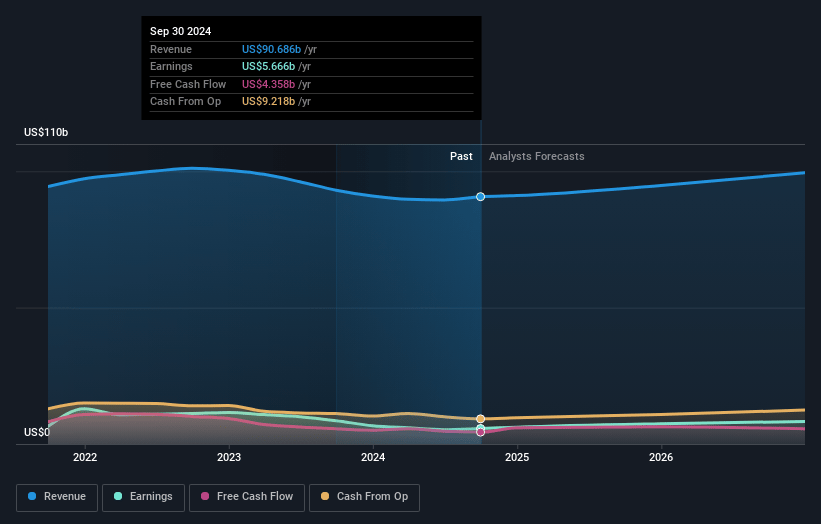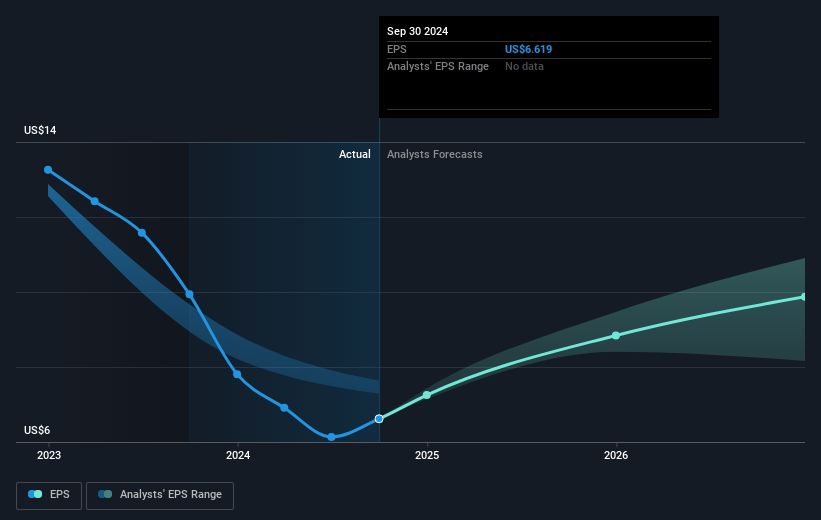Key Takeaways
- UPS's shift from Amazon aims to boost margins by focusing on higher-margin businesses, potentially enhancing revenue and long-term profitability.
- Strategic initiatives like efficiency improvements and healthcare logistics investments are expected to enhance operating margins and drive growth.
- UPS faces revenue risks with reduced Amazon deliveries and challenges in its strategy to improve margins amid operational changes and a slow-growth market reliance.
Catalysts
About United Parcel Service- A package delivery and logistics provider, offers transportation and delivery services.
- UPS plans to significantly reduce its reliance on Amazon, its largest customer, by cutting Amazon's volume by more than 50% by the second half of 2026. This decision is part of a strategy to focus on higher-margin business, which should ultimately improve their revenue per piece and operating margin over time.
- The introduction of the Efficiency Reimagined initiative is expected to save UPS approximately $1 billion through process improvements. This should support an expansion of operating margins and improvement in return on invested capital for 2025 and beyond.
- UPS has decided to in-source 100% of SurePost volume, previously using USPS for some last-mile deliveries. This move aims to leverage existing network efficiencies and improve service quality, maintaining revenue with minimal additional costs while raising rates slightly.
- UPS’s investment in its RFID-enabled Smart Package Smart Facility initiative is allowing for significant reductions in manual processes, which is expected to enhance efficiency and improve net margins by lowering operational costs.
- UPS’s strategic expansion in healthcare logistics, including recent acquisitions such as Frigo-Trans, aims to capitalize on the growing European cold chain market, with expectations to significantly expand this high-margin segment, potentially improving earnings and revenue growth in the coming years.
United Parcel Service Future Earnings and Revenue Growth
Assumptions
How have these above catalysts been quantified?- This narrative explores a more pessimistic perspective on United Parcel Service compared to the consensus, based on a Fair Value that aligns with the bearish cohort of analysts.
- The bearish analysts are assuming United Parcel Service's revenue will decrease by 1.3% annually over the next 3 years.
- The bearish analysts assume that profit margins will increase from 6.3% today to 6.9% in 3 years time.
- The bearish analysts expect earnings to reach $6.0 billion (and earnings per share of $7.29) by about April 2028, up from $5.8 billion today. The analysts are largely in agreement about this estimate.
- In order for the above numbers to justify the price target of the more bearish analyst cohort, the company would need to trade at a PE ratio of 18.4x on those 2028 earnings, up from 14.2x today. This future PE is greater than the current PE for the US Logistics industry at 18.2x.
- Analysts expect the number of shares outstanding to decline by 0.16% per year for the next 3 years.
- To value all of this in today's terms, we will use a discount rate of 7.25%, as per the Simply Wall St company report.
United Parcel Service Future Earnings Per Share Growth
Risks
What could happen that would invalidate this narrative?- UPS's revenue could be negatively impacted by the decision to significantly reduce the volume delivered for its largest customer, Amazon, by more than 50% by the second half of 2026, which will lead to lower overall volume levels and revenue dollars in the near term.
- The company's reliance on the U.S. small package market poses a risk, as it is a slow growth market with changing package characteristics, potentially impacting future revenue growth.
- The termination of the use of USPS for SurePost product delivery and in-sourcing 100% of the SurePost volume may incur additional costs, affecting net margins if operational efficiencies are not realized as expected.
- With the reconfiguration of the network and the closures of up to 10% of buildings, there is a risk of execution challenges and potential inefficiencies that could lead to increased operational costs, impacting earnings.
- The plan to achieve margin improvements amidst a significant decrease in fixed costs will require precise execution of Efficiency Reimagined initiatives and may not yield the anticipated $1 billion in savings, potentially affecting the projected operating margins and ROIC.
Valuation
How have all the factors above been brought together to estimate a fair value?- The assumed bearish price target for United Parcel Service is $106.36, which represents one standard deviation below the consensus price target of $124.01. This valuation is based on what can be assumed as the expectations of United Parcel Service's future earnings growth, profit margins and other risk factors from analysts on the more bearish end of the spectrum.
- However, there is a degree of disagreement amongst analysts, with the most bullish reporting a price target of $150.0, and the most bearish reporting a price target of just $80.0.
- In order for you to agree with the bearish analysts, you'd need to believe that by 2028, revenues will be $87.5 billion, earnings will come to $6.0 billion, and it would be trading on a PE ratio of 18.4x, assuming you use a discount rate of 7.2%.
- Given the current share price of $97.21, the bearish analyst price target of $106.36 is 8.6% higher. The relatively low difference between the current share price and the analyst bearish price target indicates that they believe on average, the company is fairly priced.
- We always encourage you to reach your own conclusions though. So sense check these analyst numbers against your own assumptions and expectations based on your understanding of the business and what you believe is probable.
How well do narratives help inform your perspective?
Disclaimer
AnalystLowTarget is an employee of Simply Wall St, but has written this narrative in their capacity as an individual investor. AnalystLowTarget holds no position in NYSE:UPS. Simply Wall St has no position in the company(s) mentioned. Simply Wall St may provide the securities issuer or related entities with website advertising services for a fee, on an arm's length basis. These relationships have no impact on the way we conduct our business, the content we host, or how our content is served to users. This narrative is general in nature and explores scenarios and estimates created by the author. The narrative does not reflect the opinions of Simply Wall St, and the views expressed are the opinion of the author alone, acting on their own behalf. These scenarios are not indicative of the company's future performance and are exploratory in the ideas they cover. The fair value estimate's are estimations only, and does not constitute a recommendation to buy or sell any stock, and they do not take account of your objectives, or your financial situation. Note that the author's analysis may not factor in the latest price-sensitive company announcements or qualitative material.







